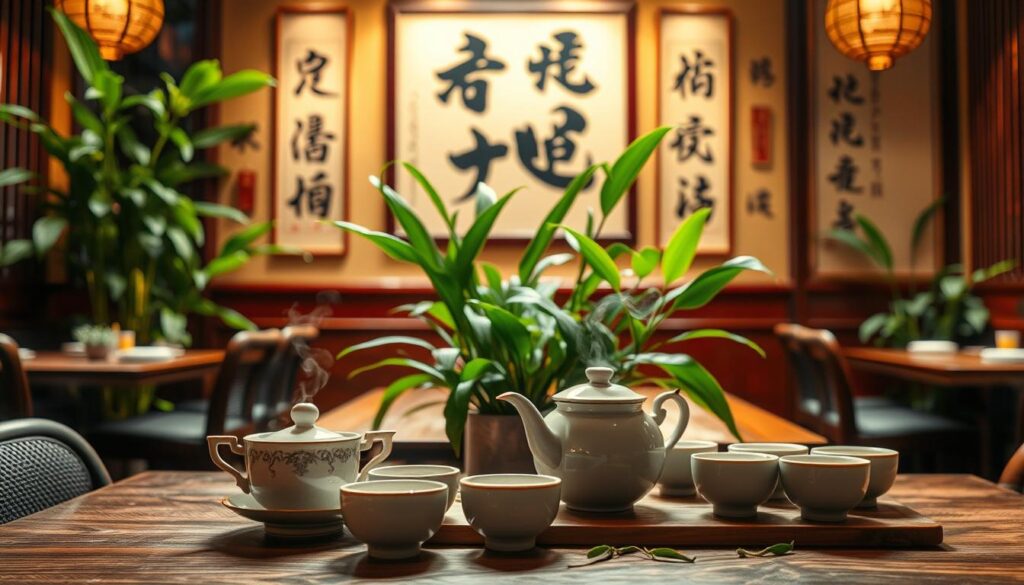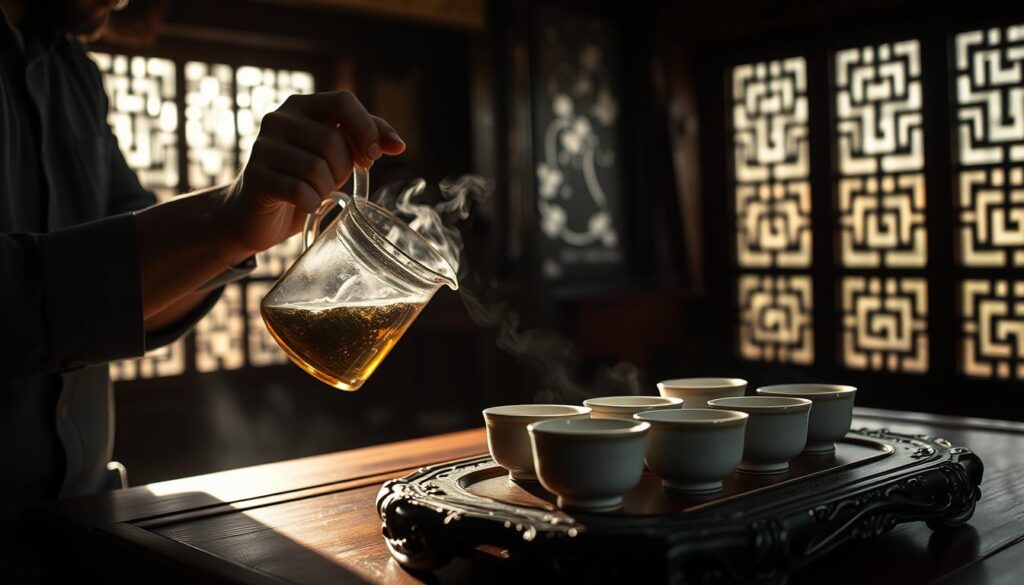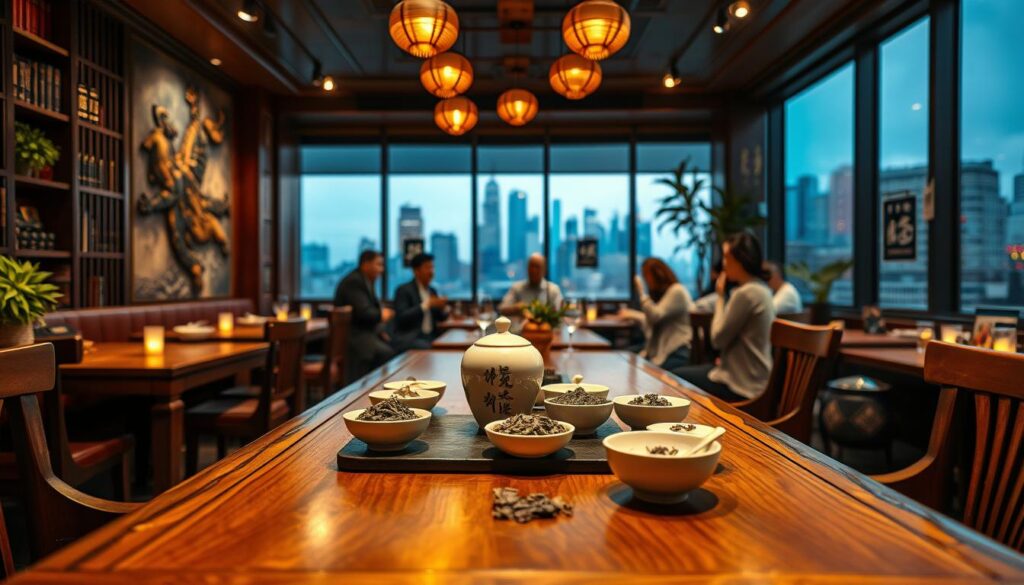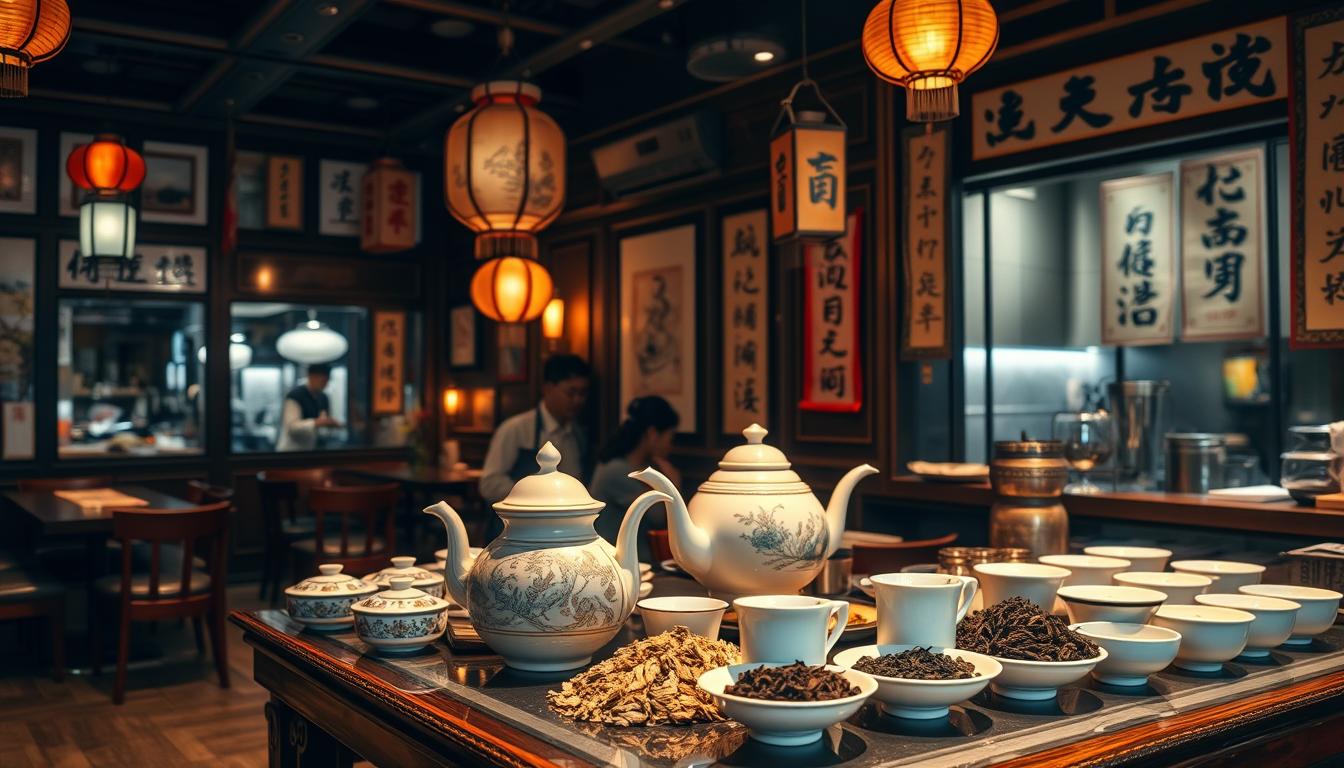What is the Tea Used in Chinese Restaurants? 5 Essential Facts to Understand
Every time I go to a Chinese restaurant, the first thing I get isn’t food—it’s a pot of fragrant tea. This moment fills me with excitement, as I watch the server pour the tea. It always takes me back to China’s rich culinary traditions. If you’ve ever wondered what is the tea used in Chinese restaurants, you’re not alone—this question opens the door to a fascinating world of flavors.
Chinese restaurant tea is more than just a drink—it’s an experience. When you try different types of Chinese restaurant tea, you’ll find a world of flavors and traditions. From light green teas to jasmine blends, each one has its own story.
Tea in Chinese dining is more than just something to drink. It’s a ritual, a way to clean your palate, and a key part of the meal. The right tea can make your food taste better, help with digestion, and give you a moment to relax. You’ll learn about popular teas, their unique qualities, and their role in Chinese food culture.
Table of Contents
Understanding Tea Culture in Chinese Restaurants
Tea is a key part of Chinese dining, more than just a drink. When you enter a Chinese restaurant, you step into a world where tea is vital. The tea service, rooted in tradition, turns a simple meal into a special journey.
Tea’s cultural value is huge, beyond its refreshing taste. In Chinese restaurants, tea does many things to make your meal better:
- Cleanses your palate between dishes
- Helps with digestion after eating
- Creates a calm and connected moment
- Shows hospitality and respect
The Role of Tea in Chinese Dining
In Chinese culture, tea is more than a drink. It’s a social tool and a sign of respect. When you’re given tea in a restaurant, it’s a sign to slow down and enjoy the moment. Pouring tea for others shows kindness, reflecting Chinese hospitality’s deep traditions.
Types of Tea Commonly Served
Chinese restaurants offer many tea types, for different tastes and meals. Green tea, oolong, and jasmine tea are favorites. Each tea has its own taste and health benefits, making choosing one a big part of your meal.
“Tea is the elixir of life, a bridge between tradition and modern dining.” – Chinese Culinary Wisdom
Types of Tea Typically Found in Chinese Restaurants
Stepping into an authentic Chinese restaurant, you’ll find tea is a big part of the meal. Chinese teas offer a wide range of flavors that go well with your food. They add a traditional touch to your dining experience.
What is the Tea Used in Chinese Restaurants?
Exploring Chinese restaurant tea reveals many choices for different tastes. Let’s look at the most popular teas you might find:
Green Tea: A Popular Choice
Green tea is a favorite in Chinese restaurants. It’s light and refreshing, making it a hit with everyone. Served hot, it’s good for your health and cleanses your palate between bites. There are many green teas, each with its own special taste:
- Longjing (Dragon Well) tea
- Bi Luo Chun
- Gunpowder green tea
Oolong Tea: A Unique Flavor Profile
Oolong tea offers a unique taste experience. It’s between green and black teas, with a balanced flavor. Restaurants often serve Oolong with heavy dishes to cut through rich tastes.
Jasmine Tea: A Fragrant Option
Jasmine tea adds elegance to your meal with its delicate floral scent. It’s loved by tea lovers for its subtle sweetness and smoothness. The tea is made by infusing green tea leaves with jasmine blossoms.
Pro tip: Ask your server about the specific tea varieties available during your visit!
How Tea is Prepared in Chinese Restaurants
The art of making traditional Chinese restaurant tea is intricate. It turns simple leaves into a wonderful drink. In Chinese tea service, it’s more than just boiling water and steeping tea leaves.
Tea preparation in Chinese restaurants needs precision and cultural knowledge. Skilled servers focus on many factors to ensure the tea tastes great.
Water Temperature: The Key to Perfect Tea
Teas need specific water temperatures to taste their best. Here’s a quick guide:
- Green Tea: 160-180°F (cool water preserves delicate flavors)
- Oolong Tea: 180-200°F (slightly hotter to release complex notes)
- Black Tea: 200-212°F (boiling water extracts robust flavors)
Traditional Teapots vs Modern Brewing Methods
Chinese restaurants use two main ways to prepare tea:
- Traditional Clay Teapots (Yixing): Handcrafted vessels that enhance tea’s natural characteristics
- Modern Stainless Steel or Glass Brewing Equipment: Practical for high-volume service
Each method adds something special to the tea experience. They balance tradition with modern needs in dining.
Health Benefits of Chinese Teas


Chinese restaurant tea is more than a tasty drink. It’s filled with health benefits that can change your wellness routine. These teas are not just for drinking during meals. They are also natural health boosters.
Exploring Chinese restaurant tea opens up a world of nutritional benefits. Each sip offers a mix of health support.
Antioxidants and Wellness
The antioxidants in Chinese restaurant tea protect your body from harmful free radicals. These compounds do a lot:
- Reduce cellular damage
- Support immune system function
- Potentially lower risk of chronic diseases
- Promote overall cellular health
Digestive Benefits of Tea
Teas in Chinese restaurants have special digestive benefits. Green and oolong teas can:
- Stimulate metabolism
- Improve digestion after meals
- Reduce bloating
- Support gut microbiome balance
Pro tip: Drinking tea between courses can aid digestion and enhance your overall dining experience.
Traditional Chinese medicine has long recognized tea as a powerful wellness tool, connecting nutrition with holistic health.
Pairing Tea with Chinese Cuisine
Exploring tea pairing can make your dining at the best chinese restaurant tea places better. The right tea can make your meal even more enjoyable. It creates a perfect balance of flavors that pleases your taste buds.
To understand tea pairings, you need to know about flavors and cooking traditions. The authentic chinese restaurant tea options are great for enhancing different dishes.
Complementing Flavors: A Culinary Journey
When picking the perfect tea, keep these tips in mind:
- Match tea strength with dish intensity
- Balance rich foods with lighter teas
- Consider regional cuisine traditions
Strategic Tea Pairings for Chinese Dishes
Each tea adds something special to your meal:
- Green Tea: Great with light seafood and dim sum
- Oolong Tea: Best for roasted meats and spicy dishes
- Jasmine Tea: Goes well with delicate flavors like steamed dumplings
Pro tip: Try different tea and dish combinations. Find your favorites at your local authentic chinese restaurant tea service.
The Ceremony of Tea in Chinese Culture
Traditional Chinese restaurant tea service is more than just a drink. It’s a deep cultural experience that turns dining into an art. The ritual of tea preparation and serving holds deep symbolic meaning. It connects diners to centuries of culinary tradition.
In Chinese culture, tea is more than a simple drink. It stands for respect, hospitality, and social connection. The chinese tea service in restaurants follows detailed protocols. These reflect centuries of refined social interactions.
Importance of Serving Tea Properly
Proper tea service involves several key steps:
- Warming the teapot before steeping to enhance flavor extraction
- Using precise water temperatures for different tea varieties
- Pouring tea in a smooth, continuous motion
- Presenting cups in a specific order of respect
The Symbolism Behind Tea
Tea rituals in traditional Chinese restaurant settings share deep cultural messages. Each gesture holds meaning:
- Offering tea first to elders shows respect
- Gentle pouring represents mindfulness
- Sharing tea symbolizes community and harmony
“Tea is the elixir of life, a bridge between people and traditions.” – Chinese Proverb
Understanding these nuanced traditions changes how you see chinese tea service in restaurants. It moves from a simple drink to a rich cultural journey.
Popular Brands of Chinese Tea Found in Restaurants
Exploring popular Chinese restaurant teas opens a world of flavors and culture. Chinese teas offer a wide range of tastes that make dining special.
Chinese restaurants are known for their top-notch tea choices. These teas match their food perfectly. They show the skill of traditional tea making.
Longjing (Dragon Well) Tea: A Royal Favorite
Longjing tea comes from Hangzhou and is the best green tea. It has special features:
- Flat, emerald-green leaves with a unique shape
- Delicate, slightly sweet taste
- Was loved by Chinese emperors
- Made by hand using old methods
Tieguanyin: The Iron Goddess of Mercy
Tieguanyin is a top oolong tea from Fujian. It’s known for:
- Complex, orchid-like scent
- Smooth, rich flavor
- Can be steeped many times
- Special processing method
“A perfect cup of tea tells a story of tradition, craftsmanship, and cultural heritage.” – Tea Master
At authentic Chinese restaurants, trying these teas will make your meal better. It will also deepen your respect for China’s tea culture.
Challenges in Reproducing Restaurant Tea at Home
Trying to make authentic Chinese restaurant tea at home can be tough. Many people find it hard to get the perfect tea like they do at their favorite Chinese restaurant. It takes patience and practice to get it right.


There are a few big challenges when trying to make Chinese restaurant tea at home. It can feel overwhelming for beginners. But, with the right mindset and a bit of effort, you can master it.
Finding Authentic Ingredients
Finding real tea leaves is the first big challenge. High-quality Chinese teas need careful picking:
- Research specialty tea shops in your area
- Explore online retailers specializing in authentic Chinese teas
- Look for reputable importers with direct connections to tea producers
- Check for certification of origin and quality
“The quality of tea begins with the leaf, not the brewing method.” – Tea Master Li
Mastering Brewing Techniques
Brewing authentic Chinese tea needs precision and practice. Key techniques include:
- Understanding water temperature for different tea types
- Using the correct tea-to-water ratio
- Selecting appropriate brewing vessels
- Controlling steeping time meticulously
Pro tip: Invest in a traditional Chinese tea set to elevate your brewing experience and capture the essence of authentic chinese restaurant tea preparation.
Don’t worry if your first tries don’t turn out right. Mastering Chinese tea brewing takes time, effort, and a true love for it. Every time you brew, you get closer to that perfect cup from your favorite restaurant.
Regional Variations in Chinese Tea
China’s vast landscape is home to a rich tapestry of tea traditions. Each region in China offers unique types of tea found in Chinese restaurants. The diversity of Chinese tea varieties shows the country’s complex culture and geography.
Tea experiences differ greatly across different provinces. This creates a fascinating journey for tea lovers. Exploring Chinese tea reveals how local environments shape unique flavors and brewing techniques.
Exploring Cantonese Tea Traditions
Cantonese tea culture is known for its delicate and refined approach. These regions specialize in light, fragrant teas. These teas complement subtle seafood and dim sum dishes well. Key characteristics include:
- Lighter brewing methods
- Emphasis on Oolong and green tea varieties
- Precise brewing temperature control
Sichuan’s Bold Tea Approach
In contrast, Sichuan province has bolder tea profiles. These teas match its spicy culinary traditions. The tea varieties here are robust and intense, designed to cut through rich, flavorful dishes.
- Stronger tea preparations
- Darker tea varieties
- More aggressive brewing techniques
Unique Provincial Tea Discoveries
Each Chinese province adds something special to the national tea landscape. From Yunnan’s misty mountains to Fujian’s coastal regions, tea reflects local terroir and cultural practices.
“Tea is more than a drink. It’s a window into regional identity and tradition.” – Chinese Tea Master
Understanding these regional variations changes how you appreciate Chinese tea. Each cup becomes a journey through geography and culture.
The Growing Popularity of Chinese Tea in the U.S.
Chinese tea culture is changing how Americans drink. Many are curious about the tea in Chinese restaurants, looking for real culinary experiences.


In the U.S., there’s a big rise in interest in Chinese restaurant teas. This change is more than just a drink. It’s about connecting with Asian traditions.
Emerging Trends in Tea Consumption
Tea trends in America are exciting:
- More people care about health
- They want real cultural experiences
- There’s a wider variety of teas
How Chinese Tea is Gaining Followers
Several things are making Chinese tea more popular:
| Factor | Impact |
|---|---|
| Health Benefits | It’s full of antioxidants and good for health |
| Cultural Exploration | People are interested in how it’s brewed |
| Culinary Diversity | Its unique flavors attract food lovers |
“Chinese tea is not just a drink, it’s an experience that connects people to centuries of tradition.” – Tea Cultural Expert
Chinese tea is bridging cultures, from special tea shops to regular restaurants. It invites Americans to try new and rich tea traditions.
Conclusion: Enhancing Your Dining Experience with Tea
Exploring the world of Chinese restaurant tea changes how you see dining. Learning about the tea used in Chinese restaurants connects you to ancient traditions. Every sip is more than a drink; it’s a way to understand Chinese food’s depth.
Trying different teas can make your dining experiences better. From light green teas to strong oolongs, each has its own taste that goes well with Chinese food. Knowing about these teas helps you see how they relate to food in a deeper way.
Exploring Different Types of Tea
Keep exploring tea as you go on your journey. Real Chinese tea is about more than taste; it’s about culture. Try teas that catch your interest, ask for staff recommendations, and be ready to try new ones. Chinese tea culture is complex and personal, with each brew offering a unique experience.
Bringing Authenticity to Your Table
It’s possible to make restaurant-quality tea at home with practice and the right ingredients. Get good teaware, buy real tea leaves, and learn how to brew. This way, you can make special moments with Chinese tea culture.


